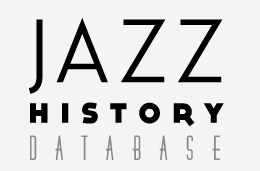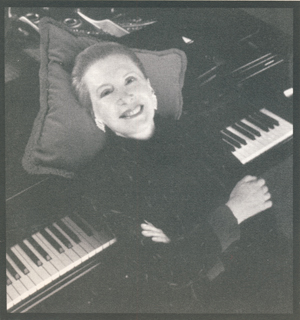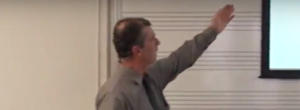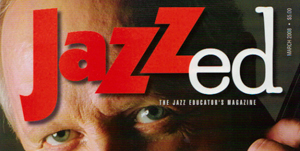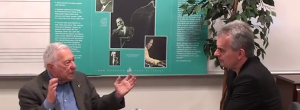Barbara Carroll
By Chet Williamson
NAME: Barbara “Bobbie” Carole Coppersmith, AKA Barbara Carroll
DOB: January 25, 1925
Born: 25 Standish Street
Parents: David L. Coppersmith and Lillian (Levine)
Instrument: Piano
Education: Worcester Public Schools, Commerce High School, New England Conservatory
Private Instruction: Worcester teachers Minner Gruber and Martha Cantor
Awards: Carroll is the 1998 recipient MAC Award (Manhattan Association of Carbarets and Clubs) for Best Major Jazz Performance (Selected as a leader).
Worcester Playing Experience: Commerce High School Orchestra, and with bands, trios and quartets on commercial dates, as she has said, “mostly weddings.”
Playing experience: Carroll’s extensive resume ranges from appearances in concert halls and jazz clubs to major TV shows and festival stages throughout the world, including the London House in Chicago, the Black Hawk in San Francisco, the Club Downbeat on 52nd Street (opening for Dizzy Gillespie), and at the Embers (playing opposite Art Tatum) in New York.
Tours and Highlights: In 1957 she was named to the roster of Steinway Artists (the only other jazz pianist at the time was Duke Ellington). Played in the Broadway show, Me and Juliet, featuring the music of Richard Rodgers and Oscar Hammerstein. Carroll also performed for President and Mrs. Clinton at the White House and made appearances at Carnegie Hall with Benny Goodman and with her trio at the Newport Jazz Festival in New York.
Television shows: “Today Show” with Dave Garroway (backing Billie Holiday as she sings God Bless the Child), “The Dinah Shore Show” (while Dinah sings How High the Moon)
Filmography: Hollywood Ending by Woody Allen
Select Discography: In her illustrious career Carroll has recorded more than 30 albums. A partial list of her releases includes: Piano Panorama (Atlantic), The Barbara Carroll Trio (RCA), Lullaby in Rhythm (RCA), It’s a Wonderful World (RCA), Barbara Carroll (Blue Note), At the Piano (Discovery), Live at the Carlye (DRG, Cabaret), and One Morning in May (After 9 Records), Live at Birdland (Harbinger).
Compositions: She has 17 pieces listed with The American Society of Composers, Authors and Publishers (ASCAP).
Press quotes: “Barbara Carroll has kept the faith. Some of her contemporaries, who came up through the ranks during the modern jazz revolution, have long since forgotten their roots. Others have allowed time to dry up their creative juices; yesterday’s innovations become today’s clichés. But this svelte and graceful lady, who emulated Bud Powell on 52nd Street before she charmed diners at the Embers on New York’s East Side, did not merely survive the changing times; she has grown demonstrably, and this in spite of a long, self-imposed retirement.” – Leonard Feather from the Blue Note LP, Barbara Carroll.
Rex Reed: “Barbara Carroll plays the Lester Young used to play because she knows all the lyrics and she thinks and emphasizes words instead of just hitting notes. The music sounds different on her piano than anybody else’s, because her fingers have personal messages in their touch, like felt mallets hitting your heartstrings. She makes it sound so effortless, yet it’s complicated enough to baffle the mathematical Messiahs at M.I.T.”
______________________________________________________
Worcester’s June Street Jazzbird by Chet Williamson
Born Barbara Carole Coppersmith at 25 Standish Street and raised at 43 June Street in Worcester, Carroll began playing piano as a child. While she studied classical music throughout her academic career, Carroll simultaneously nurtured an abiding love for jazz.
Her father was an electrician by trade who also played the trumpet and piano. Barbara was the youngest of the family’s three daughters. In a September 22, 1957 article in the Worcester Sunday Telegram, Barbara told writer Lois Innis that by the age of 4 she already loved the sound of the piano and began climbing up on the piano bench to, “investigate the mysteries of the ivory and ebony keyboard. It was all my own idea,” Carroll said. “Sometimes I’d play things I’d heard on the radio. Other times, I’d make up my own songs.”
Impressed by his youngest’ eagerness, her father taught her all he could before taking her to Ms. Minnie Gruber for lessons. “She got married later and I lost track of her, but she was a marvelous teacher,” Carroll said. “I didn’t appreciate it at the time. She encouraged me to do everything I wanted. Some of the teachers threw up their hands in horror if you even mentioned popular music, but she didn’t. As long as I did my practicing, she encouraged me to try experimenting and improvising.”
Innis also reported that Carroll was always interested in jazz, but “for a long time didn’t know it was jazz she was playing when she took a popular tune and used it as a springboard for improvisation.”
“Like a lot of jazz musicians,” Carroll said. “I also tried to copy the styles of some of the pianists I heard on records – Nat (King) Cole – he was a pianist before he became a singer, you know, Count Basie, Art Tatum.” (T&G)
Carroll also told Downbeat magazine writer Michael Rozek that, “it was fun to improvise, much to the dismay of some of my teachers, who felt that everything should be according to a written sheet. My father had a great appreciation for music; he was a trumpeter who played weddings in the area. He was delighted when I began playing, because I had two older sisters who’d had the benefits of all kinds of music lessons but never really took to them.”
Carroll studied classical piano from about age eight to about age 15. “And,” she said, “I’m glad, because now I love to play classical music.”
After Ms. Gruber moved from Worcester, Carroll studied with Martha Cantor. She was, according to fellow pianist and Worcesterite Don Asher, “Worcester’s foremost classical piano teacher and sister of the theatrical producer Arthur Cantor.”
Carroll lived at 43 June Street, a couple of blocks from Newton Square and grew up in a time when trolley cars still ran to her Westside neighborhood.
According to Asher, lessons then were a dollar a half hour. In his book Notes From A Battered Grand, the author wrote that Ms. Cantor’s studio was at the north end of Main Street. He also reports that as teenagers, both he and Carroll were members of the Classical High Gang, an unofficial group of local jazz fans.
Carroll told Downbeat, that by the time she reached high school she was listening to jazz, particularly Art Tatum, Benny Goodman, Nat Cole, and Earl Hines. “And I knew that was the direction I wanted to go. It never occurred to me – I was young and perhaps rather stupid – that as a female it might be more difficult for me.”
Asher said that Carroll also became aware of Jaki Byard, a phenomenal young pianist, fellow Commerce High student, who was already active working in the neighborhood clubs of the Laurel/Clayton section of town. “She had made her pilgrimage to Dominic’s Café,” Asher wrote, “which was becoming a Mecca for Southern New England piano players. (Hearing Jackie [Jaki Byard] in that environment was like encountering Horowitz on a drink-stained spinet in a back-road cocktail lounge.)”
Asher also took note of his classmate’s diligence in her pursuit of jazz.
“I would see [Carroll] near the front of the line at the Plymouth Theater on Sunday afternoons and in tiny cubicles at Carl Seder’s Music Mart listening to King Cole and Teddy Wilson records, head bent, eyes closed,” Asher said. “Then suddenly she had deserted Martha Cantor and was playing three and four nights a week in the east-side Worcester dives and turnpike roadhouses strung halfway to Boston like dingy boxcars on a coal-littered siding.”
The late Asher, who was also a very fine pianist, further noted that he too would be jamming the blues in the local clubs, much to the dismay of his teacher, Ms. Cantor. “She was devastated,” he wrote. “Two of her prize pupils jumping ship in the space of a month to vanish, perhaps forever, beneath the waves of vulgarity.”
Carroll is a little more circumspect in regards to her first Worcester gigs. “I’d work weekends, holidays, accompany singers, all the odd jobs that a girl piano player gets to do.” (T&G)
In a National Public Radio interview with Terri Gross, Carroll expounded on her experience. “We had a little group in high school,” she said. “We used to play Bar Mitzvahs, weddings and things like that. It was usually three or four pieces … clarinet, drums – not the greatest instrumental assortment, but we worked with what we had. We played some jazz. It was all head arrangements. You couldn’t classify it as arrangements. It was just getting together and playing tunes.” Seen Here
Carroll was also active in the Commerce High School Orchestra and began studying privately with unnamed teachers in Boston. In an interview with Marian McPartland on “Piano Jazz,” Carroll talked about her transformation from a classical pianist to jazz player. “It wasn’t anything that I sat down and formulated and analyzed. It was something that I innately knew I wanted to do. There was never any question in my mind. Because I was young and innocent, I suppose, and very naive, it never occurred to me that it might be very difficult for me to do these things. Number one, because it was difficult to play jazz anyway -- it wasn’t a stable kind of living -- secondly, because I was a female. That was relatively unheard of in those days.”
After graduating from high school in 1943, Carroll moved to Boston to attend the New England Conservatory of Music. She earned tuition money gigging around the hub. “My parents didn’t send me with their money,” she said, “only their blessing, because things were very tough financially.” (DB)
Carroll’s stay at NEC was brief, because as she reported, “I wanted to go to New York. I went to school for awhile and began playing in various clubs around Boston, at the Mayfair and the Latin Quarter. In those days they had a house band and what they called a relief band, which was a rumba band. And lucky me,” she said sarcastically. “I played with the rumba band. I learned a lot of rumbas that way.” (WPI interview)
Carroll also worked with bandleader Ruby Newman, who was instrumental in her making connections in Boston. “He was a society bandleader, who got me my union card, which was very nice. It allowed me to work,” she said.
In a biographical sketch on Carroll by writer Sue Terry in the New York’s Musician’s Local 802 newsletter, she notes that the pianist eventually left school to pursue music full time. “In those days you worked real late, ’til 2 or 3 in the morning,” the pianist said. “It was hard to get up and go to school every day.”
In his book 50 Greatest Jazz Piano Players of All Time, author Gene Rizzo writes, “Convinced that her interest in jazz was not sufficiently addressed [at NEC], she attended for only a year. While leading an all-girl trio for USO shows at Army camps in and around New England during the last days of WWII, she adopted a modified spelling of her middle name (Carole) as a surname (replacing Coppersmith).”
NPR’s Terri Gross reported: “She was accepted into the Boston AFM chapter in 1944, a necessity in order to work in area clubs. Her talents as a pianist on the Boston scene, which also included a stint with a four-piece rumba band brought her to the attention of United States military personnel. They enlisted her to do a USO tour with an all-woman trio, Elinor Sherry and the Swing Hearts.”
Carroll recalls, “The guitarist was a wonderful musician named Marion Gange, who had been with the Ina Ray Hutton band. So we had this little trio and we went to play the hospitals, playing for the boys who had been injured, who were blind, or amputees. There was a whole troupe - a juggler, musicians, singers, about 15 people - who would go right into the hospital wards and play. We would start in New York and go all the way down south and out west to the coast of California and back. We played Army, Navy and Marine bases.”
The April 1, 1944 edition of Billboard listed the Swing Hearts as playing at Doc’s in Baltimore, MD.
After the war, Carroll found herself in Philadelphia. In 1946, she spent a year and a half playing solo piano in a cocktail lounge. In 1947, Carroll finally worked up the courage to move to New York. “The big city beckoned me,” she told NPR’s Terri Gross. “I got to New York City as quickly as I could.”
In an interview with Downbeat, Carroll talks about those early days of freelancing in New York and dealing with sexism. In his book, A Biographical Guide to the Great Jazz and Pop Singers, Wil Friedwald quoted Carroll: “When I first came to New York, I couldn’t get any work using my real name, so I had friends who would send me to jobs. But they would tell the contractor to look for a ‘Bobby’ Carroll. By the time they realized that ‘Bobby’ was ‘Bobbi,” who was actually Barbara, it was too late.”
Carroll told Downbeat that she would “arrive at the location, go up to the bandstand, the leader would look at me, say, ‘Who are you?’ and I’d say, ‘I’m the pianist for the evening.’ Everybody thought if you were a girl, you couldn’t play, you know.”
But, as Friedwald pointed out, “After they heard her play, Carroll was never fired, and eventually, acquired a reputation under her real name and gender identity.”
Forming her first trio, Carroll made her debut at the Club Downbeat Club at 66 West 52nd Street – then known as “Swing Street.” “I was lucky,” she said. “I played opposite Dizzy Gillespie’s big band. I had a marvelous trio, Chuck Wayne playing the guitar and Clyde Lombardi on bass. At that time, Dizzy had John Lewis playing piano, Ray Brown playing bass and James Moody on saxophone. There were two acts, Dizzy and then my trio. We were there for four weeks and it was heaven.” (See Downbeat Club ad and photo of Carroll and Gillespie). (See NPR interview)
In his book New York Nights: Performing, Producing and Writing in Gotham, author Nick Catalano quotes Carroll’s take on the city in the late 1940s. “During this exact time period, the glory days of Fifty Second Street were in full swing with bebop sweeping the street like a tornado. At The Onyx, The Three Deuces, Jimmy Ryan’s, and other clubs, the bandstands were alive with the black beboppers who had invented the music up in Harlem and were now performing it for packed houses of whites who could not get enough of it. Charlie Parker, Dizzy Gillespie, Miles Davis, Bud Powell, Oscar Pettiford, Max Roach and other black boppers ruled supreme on Swing Street, and white players of repute were fighting to access the new music and jam along.”
The energy and excitement was explosive. For Carroll, it was, “really something for a little girl from Worcester, Massachusetts.” (See: DB)
According to Pizzi, in 1948, Carroll was Benny Goodman’s next choice (following his fall out with Mary Lou Williams) to record with his short-lived bebop combo, which featured Wardell Gray on tenor saxophone.
Through Goodman, Carroll made her earliest documented recording as part of a studio band led by Ake “Stan” Hasselgard. According to Friedwald, the Swedish clarinetist was both “Benny Goodman’s only protégé on his own instrument and probably the first person to play bebop on that instrument.” Hear a Youtube clip of Cottontop, recorded in November 18, 1948
Friedwald also reported that over the next few years, before her self-imposed retirement, Carroll recorded on “many classic early modern jazz sessions, including a live recording at the Royal Roost (with J.J. Johnson, Lee Konitz, Cecil Payne, Buddy DeFranco and Max Roach) in which she spells Bud Powell himself for one number and a fabulous studio date (with Red Rodney, Serge Chaloff, Al Cohn, and Oscar Pettiford) that’s been issued under both Chaloff and Pettiford’s names at different times.”
After the Club Downbeat, Carroll’s next steady gig in New York was at Georgie Auld’s Tin Pan Alley in the Hotel Markwell, at 49th and Broadway, where she worked as a single. Seen Here
In his book, A Different Drummer: What Makes Me Tic, a Memoir, author Herb Waxman recalls sitting in with Carroll at Tin Pan Alley. “Musicians brought drums and basses and sat in with her,” he recalled. He also noted that Carroll knew how to “please her public. She knew hundreds of good songs and we could always improvise an instant arrangement that almost sounded rehearsed. She did some standard songs and others that were carefully selected from those submitted to her by unusual Tin Pan Alley writers.
“We played jazz originals like Carisi’s “Springville,” Chuck Wayne instrumentals and I wrote some tag lyrics to standards and a hit parody of “You’re the Top” called “You’re the Bop.””
According to Friedwald, Carroll’s first date as a leader happened in 1950, a date that included two originals, “Barbara’s Carol,” and “The Puppet Who Danced Bop.”
In 1951, when bassist Clyde Lombardi left to join the Woody Herman band, Carroll not only hired a replacement, she would meet her future husband, Joe Shulman, known player around New York having participated in the Miles Davis’ Birth of the Cool sessions.
Carroll recalls their meeting. “My bass player was leaving so Herb Wasserman, the drummer, suggested I call Joe, who was a friend of his. Well, at the time he was playing with Peggy Lee and name bands like Claude Thornhill. So I said, ‘Oh, he wouldn’t want to work with me. But Herb told me to call him anyway. It turned out he was at liberty and so he came down and rehearsed with us. He found he liked the musical freedom of a small group, so he stayed on.”
The new trio’s first gig was at The Embers, 161 East 54th between Lexington and Third Streets. “They always had two attractions at once,” Carroll told writer Sanford Josephson. “Lo and behold, when we got there for rehearsal, I was told that the other act was Art Tatum. I restrained myself from running out on 54th Street into the traffic. Anyway, it was such an experience because we would play and then he would go on. He was so wonderful to me, so encouraging. And having the opportunity to listen to him every night was stunning.”
Carroll told Downbeat magazine that the pianist, although intimidating, was very supportive. “The first time we were there,” she recalled, “He was very sweet and very helpful to me. He didn’t give me technical advice, but he realized it was a trauma playing opposite him, and he was very encouraging.”
These were heady times for Carroll and company. As Friedwald wrote: “Her trios and quartets provide accompaniment for such colossi as Paul Desmond, Stan Getz, and even Charlie Parker and Billie Holiday.”
Often hailed as the first feminine disciple of Bud Powell bop piano school, Carroll also began to acquire society following, playing many of the finest supper clubs in New York. She performed on stage as a jazz pianist in the Rodgers and Hammerstein production, Me and Juliet. And, through her work in theater, began to accompany cabaret singers. (See: with Sylvia Syms in a 1952 performance of Benny Carter’s “Lonely Woman” )
In 1957, tragedy hit. Her husband of three years, Schulman, died of a heart attack while the couple vacationed on Fire Island, NY. He was 33. In her grief, Carroll continued working.
“After he died it was very difficult, because I wanted to work, but you see I was working with a trio and I needed a bass player and so I had to audition bass players. And, it was extremely difficult. Nobody played as well as he and, of course, nobody could fill his shoes …. It took a long time to get over that.” (See NPR interview)
Making inroads into the rarified strata of New York’s supper club and cabaret circuit, Carroll’s piano style grew more refined, her melodic lines were elegantly unfurled, her harmony sensibility, smart and sophisticated. Critics also took note of her singing.
In 1960, she remarried. Her new husband was the late Bert Block, a former bandleader, photographer, and booking agent who worked for such luminaries as Erroll Garner, Lenny Bruce, Bob Dylan, Kris Kristofferson and Rita Coolidge, among others. In 1962, Carroll gave birth to her daughter, Suzanne, and announced a self-imposed retirement.
Upon her return in 1972, her sense of swing grew even more insistent. And as writer Pizzi noted, she became more aware, influenced, and “privy to Bill Evans additions to jazz’s harmonic lexicon.” (See: Everything I Love, Cabaret DRG, 1996).
In reviewing a live performance of Carroll’s (with bassist George Duvvier in tow) New York Times jazz critic John S. Wilson wrote, “Stylistically, she falls midway between two other women pianists: There is, in her playing, some of the positive-ness of Marylou Williams, as well as a suggestion of the probing qualities of Marian McPartland. But in Miss Carroll’s fingers, these qualities take on a clearly personal dimension – an attention-riveting directness that has its roots in the strongly rhythmic manner of her playing and the clean, unfussy definition of her lines and phrases.”
On her singing Friedwald wrote: “It’s possible to regard Carroll’s singing as an afterthought. To this day she sings one of every four or five numbers, whether in person or on a disc. Yet those vocals are an essential part of her appeal …. Her playing is, in itself, a marvelous tribute to the durability of the American Songbook.”
On playing jazz, Carroll said this to Marian McPartland: “It wasn’t anything that I sat down and formulated and analyzed. It was something that I innately knew I wanted to do. There was never any question in my mind. Because I was young and innocent, I suppose, and very naïve, it never occurred to me that it might be very difficult for me to do these things. Number one, because it was difficult to play jazz anyway. It wasn’t a stable kind of living. Second, because I was a female. That was relatively unheard of in those days.”
Thankfully, much of Carroll’s career has been well documented. On this site is a series of resources for further research. As of this writing, the once “little girl from Worcester,” is now in her eighth decade and celebrates life by performing regularly. In the process, the once Bebop Bobbie Carroll, this Grande dame of New York supper clubs, this great pianist, continues to nurture her illustrious legacy.
http://www.barbaracarrolljazz.com/
http://www.npr.org/templates/story/story.php?storyId=106463842
http://www.jazz.com/features-and-interviews/2009/2/15/the-octojazzarians-barbara-carroll
http://www.barbaracarrolljazz.com/
http://www.jazzhistorydatabase.com/blog-chet/?p=36
http://articles.nydailynews.com/2011-06-20/entertainment/29700792_1_big-band-art-tatum-trio
http://articles.latimes.com/1990-01-23/entertainment/ca-746_1_barbara-carroll
http://www.youtube.com/watch?v=1fZnAl_pkEM – Newport New York
egV&ved=0CEkQ6AEwAw#v=onepage&q=Barbara%20Carroll%20jazz&f=false
http://www.cduniverse.com/search/xx/music/pid/1063882/a/Benny's+Bop,+Vol.+1.htm
http://books.google.com/books?id=DizcyHFrgu4C&pg=PA210&dq=Barbara+Carroll+jazz&hl=en
&sa=X&ei=wDWjT77LPOLw0gGFmegV&ved=0CFsQ6AEwBg#v=onepage&
q=Barbara%20Carroll%20jazz&f=false
http://www.youtube.com/watch?v=JcpI3oamCMk
http://books.google.com/books?id=tScEAAAAMBAJ&pg=PA127&dq=Barbara+Carroll+piano&hl=en&sa=X&ei=Wp2pT_7vHaPV0QGU4vi-BQ&ved=0CGsQ6AEwCDge#v=onepage&q=Barbara%20Carroll%20piano&f=false
http://www.jazzprofessional.com/interviews/Barbara%20Carroll_1.htm
http://www.npr.org/templates/story/story.php?storyId=4717193
http://www.npr.org/2011/08/07/139030363/barbara-carroll-still-going-on-after-a-dizzying-career
http://www.clarehansson.com/marianmcpartland/content/pianist_50s.htm
